TOGAF (Kerangka Arsitektur The Open Group) adalah kerangka organisasi terbuka. Kerangka itu sendiri adalah kumpulan pengetahuan yang terdokumentasi dengan baik, termasuk metode yang terperinci dan seperangkat alat pendukung untuk mengembangkan arsitektur perusahaan. TOGAF 9.2 adalah versi terbaru dari kerangka tersebut.
- TOGAF dikembangkan dan dipelihara oleh anggota The Open Group dan bekerja dalam tim yang disebut Forum Arsitektur. Pengembangan pertama TOGAF versi 1 dihasilkan pada tahun 1995, dan versi-versi berikutnya dari TOGAF memperluas dan meningkatkan sistem pengetahuan ini.
- TOGAF dikembangkan melalui upaya bersama lebih dari 300 anggota forum arsitektur yang mewakili beberapa perusahaan dan organisasi terkemuka di dunia, sehingga merupakan ringkasan yang baik tentang praktik arsitektur perusahaan secara umum.
- Mengembangkan dan memelihara arsitektur perusahaan adalah proses yang kompleks yang melibatkan banyak pemangku kepentingan dan proses pengambilan keputusan. TOGAF membantu dengan mendokumentasikan spesifikasi arsitektur perusahaan, proses, dan produk kerja.
- Dengan menggunakan TOGAF, organisasi dapat mengembangkan arsitektur perusahaan yang konsisten yang mencerminkan kebutuhan pemangku kepentingan, mengadopsi praktik terbaik, dan mempertimbangkan kebutuhan saat ini serta kebutuhan bisnis yang dipersepsikan di masa depan.
Dari mana asal TOGAF?
TOGAF berasal dari Kerangka Arsitektur Teknologi Manajemen Informasi Departemen Pertahanan AS (TAFIM). TOGAF 1.0 akhirnya dirilis pada tahun 1995 setelah bertahun-tahun eksplorasi, dengan izin dari Departemen Pertahanan AS dan bantuan investasi besar dari pemerintah AS. TOGAF telah merilis versi kesembilan sejauh ini, TOGAF 9 (rilis terbaru adalah TOGAF 9.2)
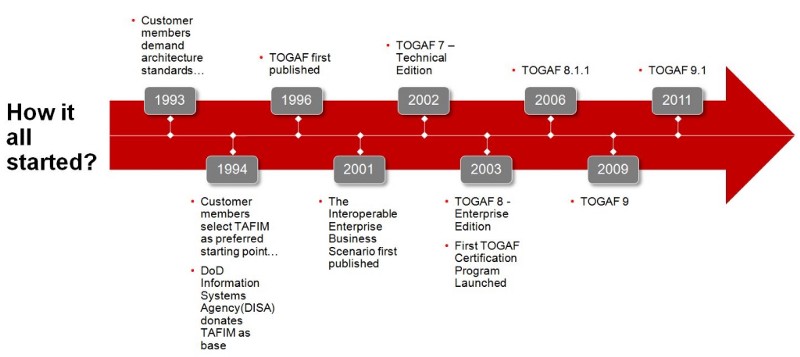
Mengapa TOGAF?
Arsitektur TI perlu mencerminkan dengan dekat tujuan bisnis organisasi. Memang, teknik tertentu (skenario bisnis) harus digunakan untuk memastikan bahwa tujuan bisnis dipahami dengan baik oleh arsitek TI, dan tercermin dalam arsitektur TI yang dikembangkan menggunakan TOGAF.

Berikut adalah alasan mengapa kita harus mengadopsi TOGAF ADM untuk pengembangan arsitektur:
- Metode umum yang komprehensif
- Pelengkap, bukan pesaing, kerangka kerja lainnya
- Diterima secara luas di pasar
- Dapat disesuaikan untuk memenuhi kebutuhan organisasi dan industri
- Tersedia di bawah lisensi gratis seumur hidup
- Standar terbuka yang netral terhadap vendor, alat, dan teknologi
- Menghindari menciptakan kembali roda
- Penyelarasan TI bisnis
- Berdasarkan praktik terbaik
- Kemungkinan untuk berpartisipasi dalam evolusi kerangka kerja
Apa itu ADM?
Metode Pengembangan Arsitektur (ADM) diterapkan untuk mengembangkan arsitektur perusahaan yang akan memenuhi kebutuhan bisnis dan teknologi informasi suatu organisasi. TOGAF ADM adalah hasil kontribusi berkelanjutan dari sejumlah besar praktisi arsitektur untuk melayani tujuan berikut:
- Ini menggambarkan metode untuk mengembangkan dan mengelola siklus hidup arsitektur perusahaan, dan membentuk inti dari TOGAF.
- Ini dapat disesuaikan dengan kebutuhan organisasi dan kemudian digunakan untuk mengelola pelaksanaan kegiatan perencanaan arsitektur.
Metode pengembangan arsitektur – sering disebut sebagai singkatan ADM – adalah proses rinci langkah demi langkah yang digunakan untuk mengembangkan atau mengubah arsitektur perusahaan.
ADM menggambarkan 10 fase yang mencakup siklus pengembangan arsitektur.
Fase-fase ini adalah:
- Tahap awal
- Fase A: Visi Arsitektur
- Fase B: Arsitektur Bisnis
- Fase C: Arsitektur Sistem Informasi
- Fase D: Arsitektur Teknis
- Fase E: Peluang dan Solusi
- Fase F: Perencanaan migrasi
- Tahap G: Menerapkan tata kelola
- Fase H: Manajemen perubahan arsitektur
- Manajemen kebutuhan
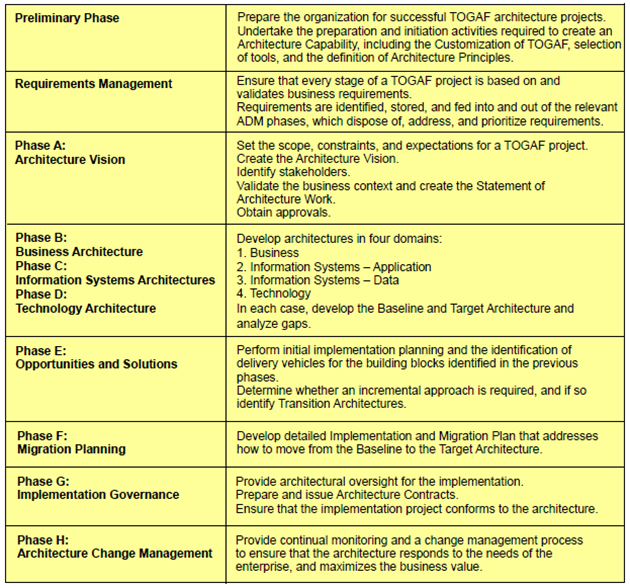
Input dan Output ADM
TOGAF menyediakan sejumlah hasil input dan output dari setiap fase:
- Ini adalah saran dan tidak perlu diikuti secara tepat
- Setiap hasil yang dihasilkan harus diberi versi untuk menunjukkan kapan perubahan telah terjadi
- Penomoran versi yang ditampilkan juga merupakan saran dan tidak perlu diikuti
Hasil yang harus disampaikan
Produk kerja yang ditentukan secara kontraktual dan kemudian ditinjau secara formal, disetujui, dan ditandatangani oleh para pemangku kepentingan. Ini biasanya akan diarsipkan setelah penyelesaian proyek, atau dialihkan ke Repository Arsitektur sebagai model referensi
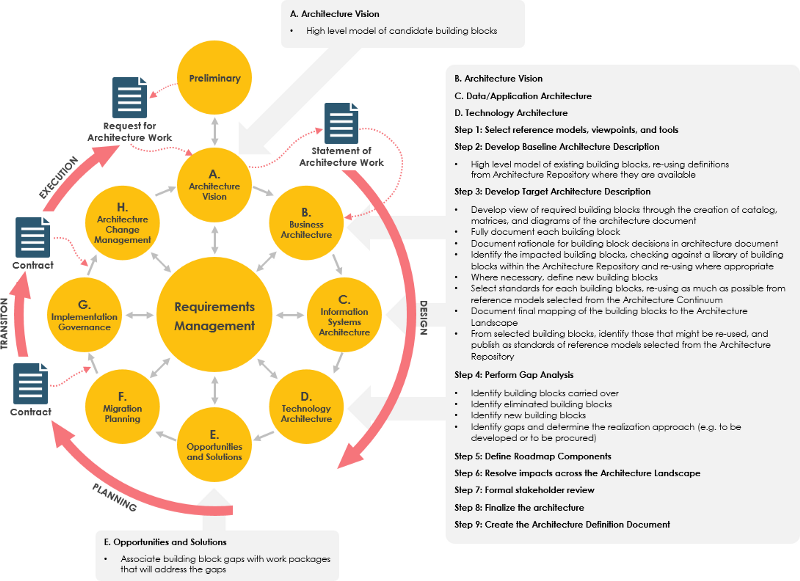
Tahap awal:
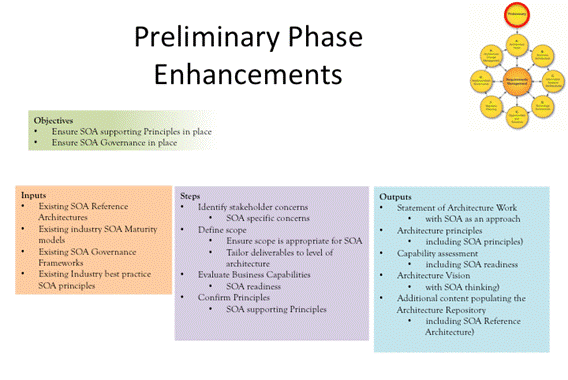
Tujuan utama dari tahap awal adalah untuk menentukan dan menetapkan kemampuan arsitektur yang diperlukan dari organisasi.
Salah satu bagian kunci adalah menentukan apa yang perlu dilakukan dan bagaimana cara mengimplementasikannya. Misalnya, keluaran utama adalah sebuahpermintaan kerja arsitekturyang menguraikan persyaratan dan memutuskan ruang lingkup, struktur, alat, atau kerangka arsitektur yang diperlukan untuk mendukung pekerjaan ini.
Pada tahap ini, TOGAF secara khusus disesuaikan untuk memenuhi kebutuhan iterasi ADM yang akan datang. Kami mendefinisikan prinsip dasar, mengevaluasi kemampuan struktur dan bisnis perusahaan untuk melakukan perubahan yang diperlukan, dan mengintegrasikan TOGAF dengan kerangka manajemen lainnya. Ada langkah-langkah di tahap ini untuk membatasi organisasi perusahaan yang terpengaruh oleh perubahan yang diusulkan, mengonfirmasi kerangka tata kelola dan dukungan yang benar, mendefinisikan dan membentuk tim dan organisasi EA, mengidentifikasi dan menetapkan prinsip arsitektur, menyesuaikan TOGAF dan kerangka lainnya, serta menerapkan alat. Di akhir fase ini, tim EA harus siap untuk mengikuti iterasi siklus ADM. Ini sebagian karena tahap awal ditunjukkan di bagian atas diagram ADM dan di luar loop utama dari tahap A hingga H.
Fase A: Visi arsitektur:
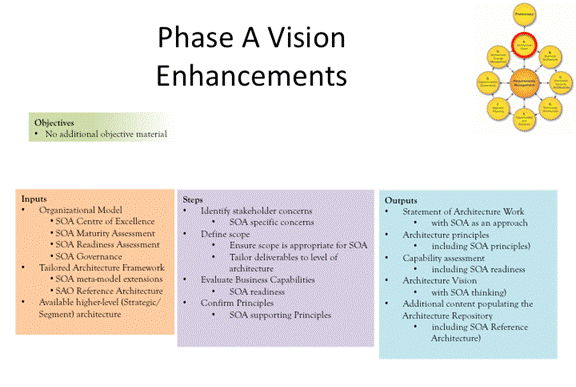
Fase A memberikan pernyataan kerja arsitektur yang jelas yang akan disediakan dalam iterasi ADM. Ini juga memberikan visi untuk arsitektur perusahaan yang diusulkan. Rasa arah ini sangat penting untuk membimbing pekerjaan ADM sepanjang proses iterasi. Pernyataanpernyataan kerja arsitekturmenentukan prosedur untuk mengembangkan dan menerapkan arsitektur yang diuraikan dalam visi arsitektur. Ini adalah visi yang memberikan keinginan tingkat tinggi untuk fungsionalitas dan nilai bisnis yang akan diberikan oleh arsitektur perusahaan yang diusulkan. Dimulai dengan aplikasi pekerjaan konstruksi, Fase A menyediakan alat (visi ini) untuk menjual manfaat dari kemampuan yang diusulkan kepada pemangku kepentingan dan pengambil keputusan di perusahaan. Skenario bisnis digunakan untuk memahami persyaratan bisnis dan membantu memperjelas persyaratan arsitektur yang diimplikasikan oleh fungsi yang diperlukan. Ini didokumentasikan dalam pernyataan kerja arsitektur dan digunakan untuk membangun konsensus untuk mendukung arsitektur akhir. Ketika organisasi sponsor menandatangani dokumen tersebut, konsensus akan muncul.
Langkah-langkah dalam Fase A adalah untuk mengubah permintaan kerja konstruksi menjadi pernyataan kerja arsitektur yang jelas, dan untuk memastikan bahwa perusahaan mampu, siap, bersedia, dan berkomitmen untuk melakukan perubahan arsitektur yang diperlukan. Ini melibatkan pembentukan proyek arsitektur, termasuk mendefinisikan ruang lingkupnya, serta mengonfirmasi dan merinci prinsip arsitektur dan bisnis. Fase A mengidentifikasi pemangku kepentingan dan kekhawatiran serta persyaratan mereka, dan mengonfirmasi tujuan bisnis, faktor pendorong, dan batasan dari fase awal. Untuk memastikan keberhasilan, ini juga menilai kemampuan bisnis, menilai kesiapan untuk transformasi bisnis, dan menyelesaikan risiko transformasi.
Fase B: Arsitektur bisnis:
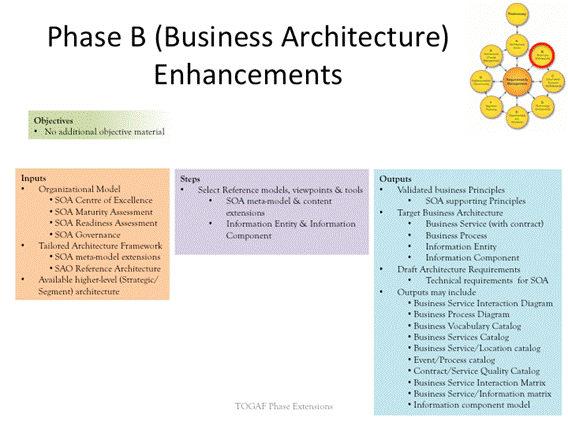
TOGAF menganggap arsitektur perusahaan sebagai cara untuk meningkatkan kemampuan bisnis-inilah sebabnya fase pengembangan arsitektur pertama berurusan denganarsitektur bisnis .
ADM dari sudut pandang bisnis — di tahap awalpermintaan kerja infrastrukturuntuk menentukan permintaan bisnis yang kuat, dan lebih lanjut disempurnakan untuk Fase A dipekerjaan infrastrukturdanpernyataan visi arsitektur
Salah satu tujuan kunci dari fase arsitektur bisnis adalah untuk mengembangkan arsitektur bisnis target, yang menunjukkan bagaimana perusahaan mewujudkan visi arsitektur dan menyelesaikan permintaan kerja arsitektur. Tujuan keduanya adalah untuk pertama-tama mengidentifikasi komponen peta jalan arsitektur kandidat untuk menjembatani kesenjangan antara baseline dan arsitektur bisnis target. TOGAF menganggap pengetahuan arsitektur bisnis sebagai prasyarat untuk pekerjaan arsitektur di bidang lain (seperti data, aplikasi, dan teknologi). Arsitektur bisnis juga menunjukkan kepada pemangku kepentingan kunci nilai komersial dan pengembalian investasi dari pekerjaan arsitektur. Model bisnis, seperti model aktivitas atau proses, kasus penggunaan dan model kelas, atau diagram koneksi node,
Ketiga fase pengembangan arsitektur (B, C, dan D) mengikuti langkah-langkah yang serupa. Penting untuk menggunakan kembali model referensi yang tersedia dan menyesuaikan semua keluaran untuk menangani sudut pandang pemangku kepentingan. Kemudian, arsitek mengembangkan deskripsi baseline dan tujuan dari arsitektur bisnis, dan melakukan analisis kesenjangan untuk menentukan bagaimana bertransformasi dari satu ke yang lain.
Fase C: Arsitektur Sistem Informasi:
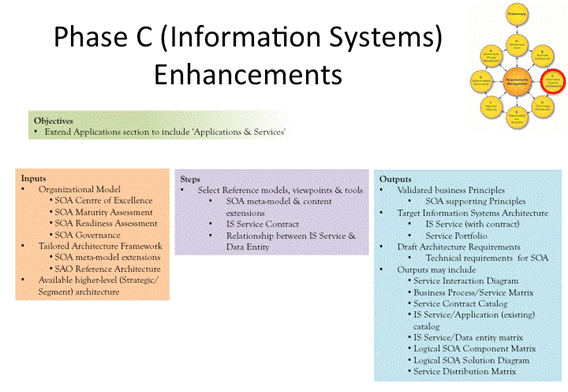
TOGAF membagi Fase C-Arsitektur Sistem Informasi-menjadi dua bagian, mencakup pengembangandatadanaplikasiarsitektur. Dokumen TOGAF memiliki bab pengantar singkat yang mencakup dua domain, diikuti oleh bab terpisah tentang data dan aplikasi. Seperti pada tahap pengembangan arsitektur lainnya (B&D), tujuannya adalah untuk mengembangkan arsitektur sistem informasi target untuk data dan aplikasi, dan untuk menentukan komponen peta jalan arsitektur kandidat berdasarkan kesenjangan antara baseline dan arsitektur target.
Fase C selalu melibatkan kombinasi arsitektur data dan aplikasi. Menyediakan keduanya termasuk, dan tidak masalah dalam urutan apapun-ada pendukung untuk kedua metode. Langkah-langkah untuk data dan aplikasi sangat mirip-pilih model referensi, sudut pandang dan alat; kembangkan baseline dan kemudian temukan deskripsi arsitektur, lakukan analisis kesenjangan dan definisikan komponen peta jalan kandidat; dan selesaikan dampak apa pun dalam lingkungan arsitektur secara keseluruhan. Setelah tinjauan pemangku kepentingan formal, arsitektur akhirnya ditentukan dan dokumen definisi arsitektur dibuat.
Perbedaan utama antara data dan aplikasi terletak pada tema, yang tercermin dalam penggunaan model referensi, teknologi, dan representasi arsitektur yang berbeda. Misalnya, arsitektur data dapat menggunakan hubungan entitas atau diagram kelas, sementara arsitektur aplikasi dapat menggunakan diagram komunikasi aplikasi atau diagram rekayasa perangkat lunak.
Fase D: Arsitektur teknis:
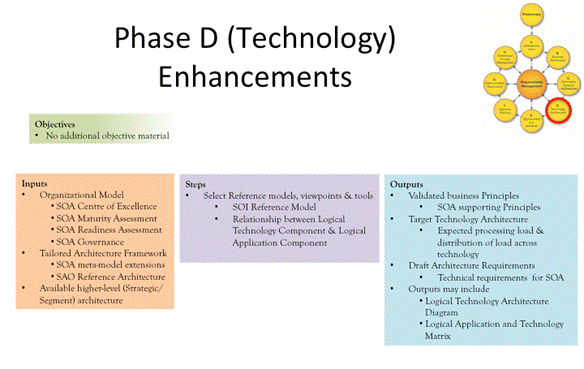
Fase D adalah fase TOGAF, yang mengembangkan arsitektur teknis untuk proyek arsitektur. Arsitektur teknologi menggambarkan struktur dan interaksi layanan platform serta komponen teknologi logis dan fisik. Fase D mengembangkan arsitektur teknologi target, yang mendukung komponen data dan aplikasi (dikembangkan di fase C) untuk mewujudkan komponen bisnis.
Arsitektur yang dikembangkan dalam fase B, C, dan D digabungkan untuk mewujudkan visi arsitektur-menyelesaikan kekhawatiran pemangku kepentingan dan permintaan kerja konstruksi. Seperti pada fase pengembangan arsitektur lainnya, Fase D mengidentifikasi komponen peta jalan arsitektur kandidat untuk mencapai transisi dari Baseline ke Target. Langkah-langkah dalam Fase D hampir sama dengan yang ada di Fase B dan Fase C-perbedaan utamanya adalah bahwa fokus sekarang adalah pada teknologi. Oleh karena itu, ini mencakup model referensi teknis dan standar atau ukuran teknis-seperti kinerja, pemeliharaan, lokasi, dan latensi atau ketersediaan.
Menentukan keluaran dan hasil yang harus disampaikan sangat penting untuk membantu membangun arsitektur teknis yang benar-benar mendukung sistem informasi dan arsitektur bisnis. Memperoleh ruang lingkup yang tepat dapat mempercepat pengembalian, sementara ruang lingkup yang terlalu besar akan menghambat implementasi yang sukses. Ini bukan tentang teknologi penerapan itu sendiri, tetapi pengembangan arsitektur teknis yang benar-benar menangani visi arsitektur dan permintaan kerja.
Fase E: Peluang dan solusi:
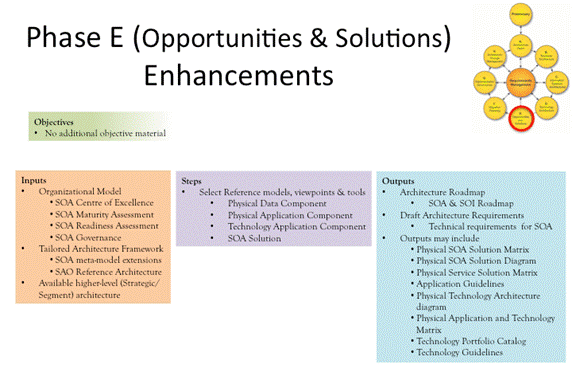
Fase E mendapatkan namanya-ini adalah untuk menemukan peluang untuk menyediakan arsitektur target dengan menerapkan solusi spesifik. Fase E menghasilkan versi lengkap pertama dari peta jalan arsitektur dengan menggabungkan rekomendasi dari analisis dan fase pengembangan bangunan-B, C, dan D.
Pada tahap ini, fokus utama adalah pada bagaimana menyediakan arsitektur. Oleh karena itu, ini berfokus pada pembuatan peta jalan arsitektur, mencantumkan paket kerja dalam garis waktu untuk mencapai arsitektur target. Ketika perubahan begitu besar sehingga tidak mungkin untuk langsung beralih dari baseline ke arsitektur target, maka tahap E akan menghasilkan pendekatan bertahap, yang terdiri dari arsitektur menengah atau transisi. Fase E memetakan perubahan arsitektur yang diperlukan ke prosedur investasi dan proyek yang memiliki dana dan sumber daya untuk melaksanakan paket kerja, dan menyediakan arsitektur transisi dan target. Input pada tahap ini hampir semuanya adalah keluaran dari tahap awal. Langkah-langkah ini mengambil keluaran ini; mengonsolidasikannya, menganalisis ketergantungan dan menyelesaikan perbedaan; dan mengonfirmasi kembali bahwa organisasi dapat melakukan perubahan. Fase E meningkatkan dan memperbarui persyaratan, dokumen arsitektur, dan peta jalan arsitektur. Keluaran kunci adalah langkah pertama dalam rencana implementasi dan migrasi.
Fase F: Perencanaan migrasi:
Tahap awal ADM mengidentifikasi kebutuhan akan perubahan arsitektur dan kemudian mengembangkan arsitektur bisnis, data, aplikasi, dan teknis untuk mendukung kebutuhan ini. Kemudian, di fase kedua, rencana implementasi dan migrasi tingkat tinggi dikembangkan untuk memanfaatkan peluang investasi dan mengidentifikasi solusi spesifik. Arsitektur Target: Fase F menyelesaikan rencana implementasi dan migrasi yang terperinci, serta peta jalan arsitektur akhir.
Ini juga memastikan bahwa rencana tersebut terkoordinasi dengan metode manajemen perubahan yang digunakan di dalam perusahaan dan rencana lainnya dalam portofolio perubahan secara keseluruhan. Akhirnya, Fase F memastikan bahwa pemangku kepentingan kunci sepenuhnya memahami nilai bisnis, biaya paket kerja, dan arsitektur transisi serta masa depan. Meskipun tahap awal ADM sangat dipandu oleh tim arsitektur perusahaan, tahap dari E hingga H memerlukan kolaborasi dengan agen perubahan lainnya.
Fase F secara khusus memerlukan kerja sama yang erat di antara empat kerangka manajemen untuk membuat rencana implementasi dan pemindahan menjadi sukses.
Empat area adalah:
- rencana bisnis
- Arsitektur Perusahaan
- Manajemen portofolio
- manajemen proyek
Melalui kerjasama, keempat area ini harus memprioritaskan pekerjaan, menggunakan kriteria seperti evaluasi kinerja, pengembalian investasi, nilai bisnis, faktor kunci keberhasilan, pengukuran efektivitas, dan kesesuaian strategis.
Tahap G: Terapkan tata kelola:
Pengembangan dan implementasi yang sebenarnya berlangsung bersamaan dengan fase G. Fase G memastikan bahwa proyek implementasi dan proyek lainnya yang sedang berlangsung sesuai dengan arsitektur yang telah ditentukan.
Biasanya, arsitektur target dikembangkan sebagai serangkaian transformasi untuk mencapai nilai bisnis dan manfaat secepat mungkin dan untuk mengurangi risiko dalam rencana transformasi. Setiap transformasi adalah langkah menuju perusahaan target untuk mewujudkan kepentingan bisnisnya sendiri.
Pada saat kita mencapai fase G, arsitektur telah dikembangkan (dalam fase A hingga D), peluang dan solusi untuk menyediakan arsitektur telah diidentifikasi (dalam fase E), dan rencana implementasi dan migrasi yang rinci telah diselesaikan (dalam fase F). Dengan demikian, peran tim arsitektur Fase G adalah untuk memberikan pengawasan terhadap implementasi arsitektur. Ini dilakukan dengan memvalidasi ruang lingkup dan prioritas penyebaran, membimbing pengembangan dan penyebaran solusi, serta melakukan tinjauan kepatuhan.
Dokumen kontrak arsitektur digunakan untuk mendorong perubahan arsitektur. Dihasilkan pada awal fase G dan disetujui oleh fungsi arsitektur dan mereka yang bertanggung jawab atas implementasi, ini adalah mekanisme untuk menilai kepatuhan tata kelola arsitektur.
Fase H: Manajemen perubahan struktur:
Tidak ada yang berjalan sesuai rencana – akan selalu ada kebutuhan baru dan perubahan pada arsitektur. Fase H menggambarkan proses manajemen perubahan untuk mengelola perubahan pada arsitektur dengan cara yang kohesif dan terstruktur. Biasanya, ini memerlukan pemantauan terus-menerus terhadap permintaan tata kelola, teknologi baru, atau perubahan dalam lingkungan bisnis.
Proses ini harus mendukung arsitektur perusahaan yang direalisasikan sebagai lingkungan dinamis yang dapat merespons perubahan ini dengan fleksibel dan berkembang dengan cepat. Dalam Fase H, penting bagi badan tata kelola untuk menetapkan standar untuk menentukan apakah permintaan perubahan memerlukan pembaruan arsitektur sederhana, atau apakah perlu memulai siklus baru dari metode pengembangan arsitektur (ADM). Perubahan harus terkait langsung dengan nilai bisnis. Cara menggunakan arsitektur perusahaan adalah bagian terpenting dari siklus pengembangan arsitektur, jadi sangat penting untuk memantau pertumbuhan dan penurunan bisnis di Fase H.
Pada akhirnya, arsitektur perusahaan yang berfungsi untuk organisasi kemarin tidak lagi mendukung fungsi saat ini atau masa depan. Output dari permintaan perubahan di Fase H dapat diklasifikasikan sebagai simplifikasi – biasanya didorong oleh kebutuhan untuk mengurangi investasi; perubahan bertahap – memerlukan nilai tambahan dari investasi yang ada; atau perubahan desain ulang, yang merupakan kebutuhan untuk meningkatkan investasi dan menciptakan nilai baru yang didorong oleh.
Manajemen kebutuhan arsitektur:
Pada setiap tahap ADM, kebutuhan untuk generasi, analisis, dan tinjauan diperlukan. Fase manajemen kebutuhan menggambarkan proses pengelolaan kebutuhan arsitektur ini sepanjang ADM. Fase manajemen kebutuhan adalah inti dari ADM – itulah sebabnya ia ditampilkan di pusat lingkaran ADM. Tahap ini menggambarkan proses manajemen kebutuhan dan bagaimana proses ini terhubung dengan tahap lain dari ADM. Kebutuhan tidak statis – mereka berkembang secara dinamis antara setiap tahap penyelesaian ADM kita dan siklus ADM.
Kebutuhan arsitektur perusahaan dan perubahan selanjutnya terhadap kebutuhan ini akan diidentifikasi, disimpan, dan input serta output yang terkait dengan fase ADM, dan antara siklus ADM. Menghadapi perubahan permintaan sangat penting. Arsitektur berurusan dengan ketidakpastian dan perubahan – ‘area abu-abu’ antara harapan pemangku kepentingan dan kemungkinan! Oleh karena itu, kebutuhan arsitektur akan selalu berubah.
Selain itu, arsitektur melibatkan banyak faktor pendorong dan batasan yang berada di luar kendali perusahaan – seperti kondisi pasar yang berubah atau undang-undang baru – yang akan menghasilkan perubahan dalam kebutuhan dengan cara yang tidak terduga.
TOGAF menekankan bahwa proses manajemen kebutuhan itu sendiri tidak akan menangani, menyelesaikan, atau memprioritaskan kebutuhan, karena ini dilakukan di fase ADM yang relevan. Tahap manajemen permintaan hanyalah proses pengelolaan permintaan di seluruh ADM.
Fase Awal ADM
Kegiatan persiapan dan inisiasi yang diperlukan untuk menciptakan Kemampuan Arsitektur termasuk kustomisasi TOGAF dan definisi Arsitektur
Hasil Keluaran:
- Prinsip arsitektur
- Repositori arsitektur
- Prinsip bisnis, tujuan bisnis, dan pendorong bisnis
- Model organisasi untuk arsitektur perusahaan
- Permintaan untuk pekerjaan arsitektur
- Kerangka arsitektur yang disesuaikan
Fase A ADM: Visi Arsitektur
Fase awal dari siklus pengembangan arsitektur. Ini mencakup informasi tentang mendefinisikan ruang lingkup inisiatif pengembangan arsitektur, mengidentifikasi pemangku kepentingan, membuat Visi Arsitektur, dan mendapatkan persetujuan untuk melanjutkan pengembangan arsitektur
Hasil Keluaran:
- Prinsip arsitektur
- Peta jalan arsitektur
- Visi arsitektur
- Prinsip bisnis, tujuan bisnis, dan pendorong bisnis
- Penilaian kemampuan
- Rencana komunikasi
- Pernyataan pekerjaan arsitektur
- Kerangka arsitektur yang disesuaikan
Fase B ADM: Arsitektur Bisnis
Arsitektur Bisnis: pengembangan Arsitektur Bisnis untuk mendukung Visi Arsitektur yang disepakati
Hasil Keluaran:
- Dokumen definisi arsitektur
- Prinsip arsitektur
- Spesifikasi kebutuhan arsitektur
- Peta jalan arsitektur
- Prinsip bisnis, tujuan bisnis, dan pendorong bisnis
- Pernyataan pekerjaan arsitektur
Fase C ADM: Arsitektur Sistem Informasi
Arsitektur Sistem Informasi: pengembangan Arsitektur Sistem Informasi untuk mendukung Visi Arsitektur yang disepakati
- Dokumen definisi arsitektur
- Prinsip arsitektur
- Spesifikasi kebutuhan arsitektur
- Peta jalan arsitektur
- Pernyataan pekerjaan arsitektur
Fase D ADM: Arsitektur Teknologi
Arsitektur Teknologi: pengembangan Arsitektur Teknologi untuk mendukung Visi Arsitektur yang disepakati
Hasil Keluaran:
- Dokumen definisi arsitektur
- Prinsip arsitektur
- Spesifikasi kebutuhan arsitektur
- Peta jalan arsitektur
- Pernyataan pekerjaan arsitektur
Fase E ADM: Peluang & Solusi
Peluang & Solusi melakukan perencanaan implementasi awal dan identifikasi kendaraan pengiriman untuk arsitektur yang ditentukan dalam fase sebelumnya
Hasil Keluaran:
- Dokumen definisi arsitektur
- Spesifikasi kebutuhan arsitektur
- Peta jalan arsitektur
- Visi arsitektur
- Penilaian kapabilitas
- Rencana implementasi dan migrasi
- Pernyataan pekerjaan arsitektur
Fase F ADM: Perencanaan Migrasi
Perencanaan Migrasi membahas bagaimana cara berpindah dari Arsitektur Dasar ke Arsitektur Target dengan menyelesaikan Rencana Implementasi dan Migrasi yang terperinci
- Blok bangunan arsitektur
- Dokumen definisi arsitektur
- Spesifikasi kebutuhan arsitektur
- Peta jalan arsitektur
- Permintaan perubahan Rencana implementasi dan migrasi
- Rencana tata kelola implementasi
- Permintaan untuk pekerjaan arsitektur
- Pernyataan pekerjaan arsitektur
Fase G ADM: Tata Kelola Implementasi
Tata Kelola Implementasi memberikan pengawasan arsitektur terhadap implementasi
Hasil Keluaran:
- Permintaan perubahan
- Penilaian kepatuhan
- Blok bangunan solusi
- Pernyataan pekerjaan arsitektur
Fase H ADM: Manajemen Perubahan Arsitektur
Manajemen Perubahan Arsitektur menetapkan prosedur untuk mengelola perubahan pada arsitektur baru Manajemen Kebutuhan memeriksa proses pengelolaan kebutuhan arsitektur sepanjang ADM
Ringkasan
ADM adalah metode umum yang komprehensif
- Ini merekomendasikan urutan untuk berbagai fase dan langkah yang terlibat dalam mengembangkan arsitektur
- Ini adalah metode iteratif
- Ini mengacu pada bagian lain dari TOGAF untuk aset dan proses
- Ini dapat digunakan dengan hasil keluaran lain dari kerangka kerja lainnya
Berikut adalah gambaran umum TOGAF ADM untuk setiap fase pengembangan seperti yang ditunjukkan pada Gambar berikut:
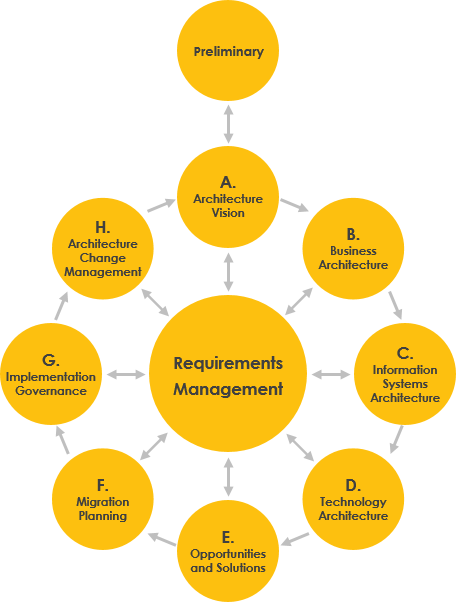
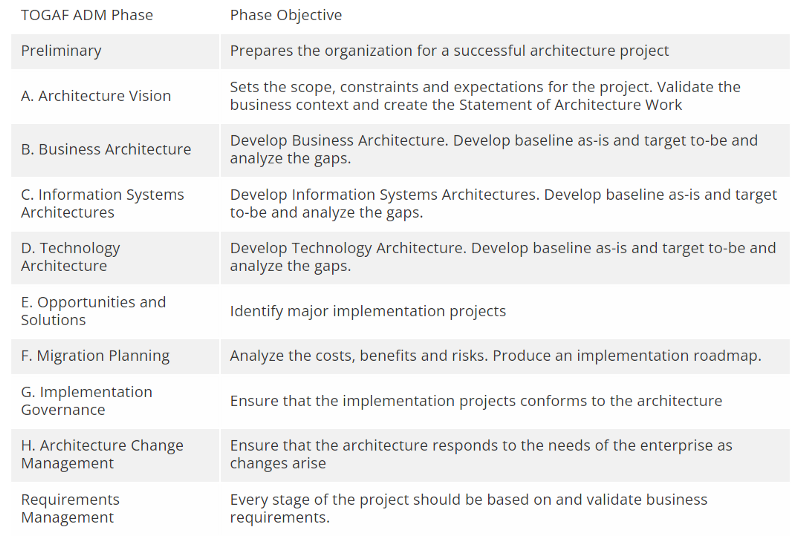
- Lebih banyak tentang Panduan TOGAF ADM
- Lebih banyak tentang Template TOGAF Just-in-Time
- Lebih banyak tentang alat ArchiMate
- Coba Visual Paradigm GRATIS
Referensi Pengenalan TOGAF
- Apa itu TOGAF?
- Tutorial TOGAF ADM
- Kerangka TOGAF 9.1 – Panduan Komprehensif
- Perangkat Lunak TOGAF untuk Arsitektur Perusahaan
- Perangkat Lunak TOGAF Terbaik
ArchiMate 3
- Apa itu ArchiMate?
- Panduan Penuh Sudut Pandang ArchiMate
- Pembaruan ArchiMate 3
- Apa yang Baru di ArchiMate 3?
- Menggunakan Alat ArchiMate dengan TOGAF ADM
This post is also available in Deutsch, English, Español, فارسی, Français, 日本語, Polski, Portuguese, Ру́сский, Việt Nam, 简体中文 and 繁體中文.













